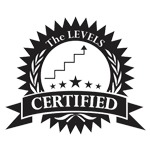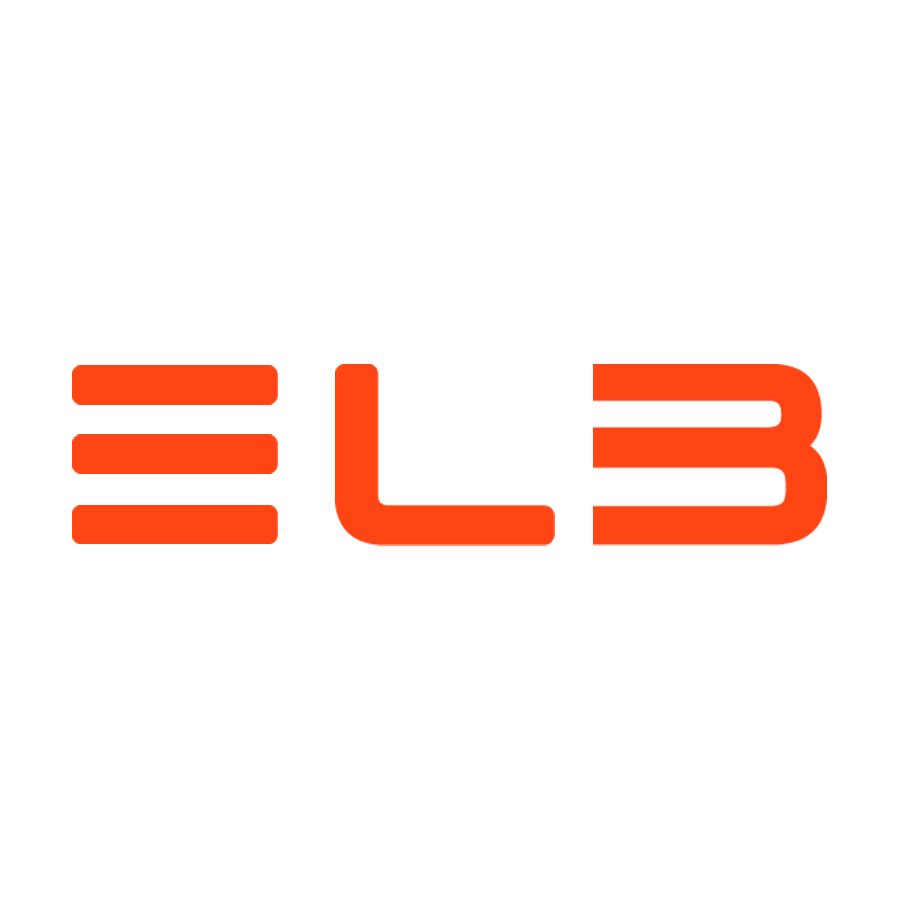With more and more choices of lithium batteries, many friends want to know the difference and advantages between LiFePO4 battery vs Lithium Ion batteries. This article will let you know more info accordingly.
What is LiFePO4 Battery?
LiFePO4 batteries also means LFP battery, which is a highly stable but slightly less energy dense battery composition. The iron and phosphate used to make the cathode are abundant and cheap than some of the materials used in NMC batteries – mainly cobalt. In addition, the materials in LiFePO4 batteries are far less toxic than those in NMC, making them easier to recycle at the end of their life.
Currently, more and more companies have been manufacturing LiFePO4 batteries as opposed to NMC for home energy storage. Mostly because LiFePO4 batteries are safer and more stable. In ELB, there are two model are popular in home energy storage system:
The big headlines this year in terms of LiFePO4 batteries have been about Tesla undoubtedly. Tesla announced in 2022 that they would be switching all Standard Range models to LiFePO4 battery chemistries.
LiFePO4 Summary Table
| Voltages | 3.20, 3.30V nominal; typical operating range 2.5–3.65V/cell |
| Specific energy (capacity) | 90–120Wh/kg |
| Charge (C-rate) | 1C typical, charges to 3.65V; 3h charge time typical |
| Discharge (C-rate) | 1C, 25C on some cells; 40A pulse (2s); 2.50V cut-off (lower that 2V causes damage) |
| Cycle life | 2000 and higher (related to depth of discharge, temperature) |
| Thermal runaway | 270°C (518°F) Very safe battery even if fully charged |
| Cost | ~$200 per kWh |
| Applications | ESS, EVs, etc |
Advantages of LiFePO4 battery?
Safety: LiFePO4 battery are more stable and has no risk for fire or explosion especially.
High temperature sustainability: LiFePO4 batteries perform in wide range of temperature (≤60°C), which means LiFePO4 battery can handle far wider variations in temperature than other chemistries.
Long cycle life: The cycle life of LiFePO4 battery can last 6000 times, however the cycle life of NCM is around 1000.
Warranty: As cycle life is higher, so warranty is also higher for LifePO4 battery compared to NCM Battery as well. So in the long run, LifePO4 battery can be proved ideal.
Full charge condition tolerance: LiFePO4 is more tolerant to full charge conditions and is less stressed than other lithium ion systems if kept at high voltage for a prolonged time.
Energy required to produce: LiFePO4 battery requires less amount of energy to be produced compared to other battery, exercising lesser impact onto its environment.
What is Lithium ion battery?
The most widely cited lithium ion battery is the ternary battery, we also call it as NMC battery also means NiCoMn ternary battery. Which is a very high specific energy or power battery. This limitation of “energy” or “power” makes them more commonly used in power tools or electric cars.
NMC lithium ion batteries typically have a lower upfront cost but may need to be replaced over the lifetime of the vessel depending on the operational profile. NMC lithium ion batteries have been the subject of a number of investigations around fires on both land-based and marine installations, leading some companies, such as Tesla, to completely switch over to the use of LiFePO4 chemistry for the EVs.
NMC Lithium Ion Battery Summary Table
| Voltages | 3.60V, 3.70V nominal; typical operating range 3.0–4.2V/cell, or higher |
| Specific energy (capacity) | 150–220Wh/kg |
| Charge (C-rate) | 0.7–1C, charges to 4.20V, some go to 4.30V; 3h charge typical. Charge current above 1C shortens battery life. |
| Discharge (C-rate) | 1C; 2C possible on some cells; 2.50V cut-off |
| Cycle life | 1000–2000 (related to depth of discharge, temperature) |
| Thermal runaway | 210°C (410°F) typical. High charge promotes thermal runaway |
| Cost | ~$420 per kWh |
| Applications | E-bikes, medical devices, EVs, industrial |
Advantages of Lithium ion battery?
High energy density: At present NCM Lithium ion batteries are preferred in some specific applications like electric vehicles, because they have lesser space requirement due to the higher energy density.NCM Lithium ion battery features higher power rating and energy density compared to LiFePO4 battery due to its higher lithium diffusion rate and electron mobility.
Low price: NCM Lithium ion cell voltage is 3.7V where as LiFePO4 battery is 3.2V, that’s why in a battery pack it takes less NCM lithium ion cells to fulfill, thus the price of the NCM lithium battery pack is little cheaper than LFP. Which attracts some users.
Which is the best? LiFePO4 battery vs Lithium Ion Battery?
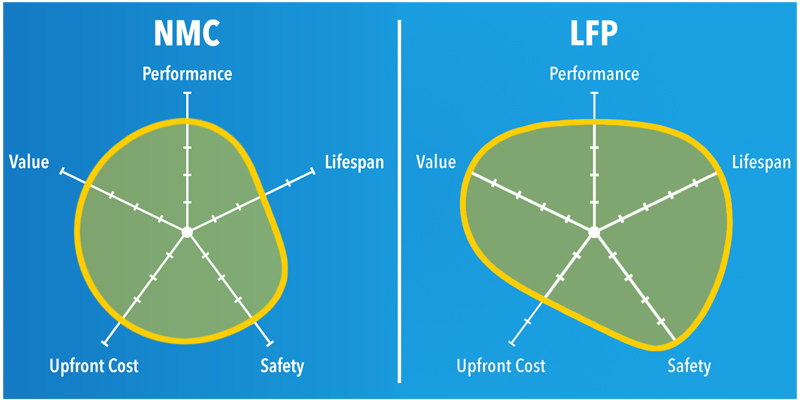
Performance
Overall, the overall performance of NMC lithium ion cell and LiFePO4 cells is almost the same. You can find these two types in a variety of sizes, from as little as 0.5 kWh to over 100 kWh. Most homeowners only need about 10 kWh of storage, and you can definitely find it from both types.
That being said, there are some subtle differences between the two. Compared to NMC lithium battery, LiFePO4 battery are slightly more efficient and operate better at lower states of charge, but NMCs can tolerate cooler temperatures better. However, if your battery is installed inside, or if you’re in an area that doesn’t experience significant temperature extremes, you probably don’t need to worry about this.
NMC Lithium ion batteries also have higher energy density, which means they will be physically smaller than LiFePO4 batteries of the same capacity. This is usually not a concern for homeowners, but if you have limited space then you may want to consider NMC lithium ion batteries.
Lifespan
Generally speaking, the cycle life of LiFePO4 battery is more than 6000 times, while the life of ternary lithium ion battery is generally 800-1000 times.
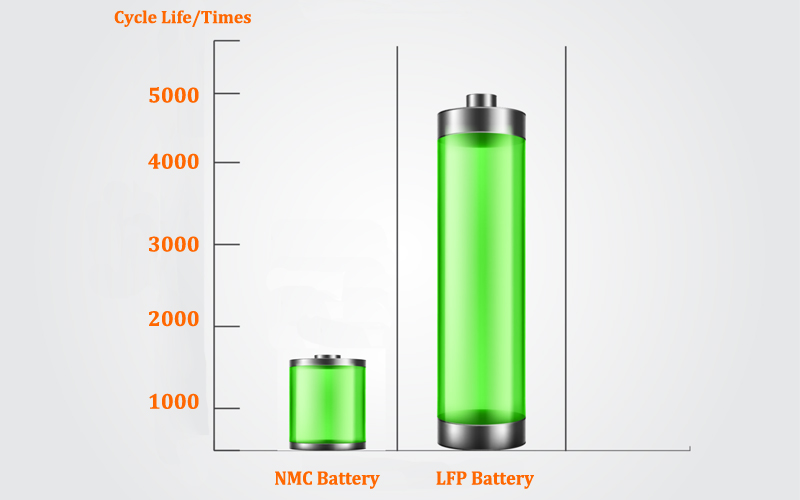
Safety
One of the biggest benefits of choosing an LiFePO4 battery is its safety and lifespan. The combination of lithium iron phosphate is more stable than nickel manganese cobalt at higher temperatures.
Additionally, LiFePO4 batteries can better handle greater power consumption. Therefore, LiFePO4 cells are less likely to experience thermal runaway. In short, LiFePO4 batteries are less likely to catch fire than NMC lithium ion batteries.
This is not to say that if you install an NMC lithium ion battery, it will spontaneously ignite. However, if the NMC lithium ion battery is overstressed or mishandled, there is a higher chance of problems. That’s why it’s important to use a licensed, trusted battery installer to minimize the chance of problems.
Upfront Cost
NMC batteries tend to be a little more expensive than LiFePO4 batteries.
Also, the LiFePO4 battery is slightly larger, and the cabinet housing the LiFePO4 battery may also require more material.
Value
We’re just saying that NMC lithium ion batteries have a lower upfront cost. However, LiFePO4 batteries can give you great value for money.
According to the price of each cycle life, the price per cycle of LFP Battery is only 1/3 of the price per cycle of NCM lithium ion battery basically.
Charge-Discharge Curve
Let’s compare the charge-discharge curves of LiFepo4 Battery Vs Lithium Ion batteries:
The state of charge (SOC) of an NCM battery varies significantly by its voltage level.
On the other hand, the SOC level of lithium iron phosphate batteries, due to its flat charge-discharge curve, is not easy to distinguish by voltage level.
Therefore, accurate SOC diagnosis of NCM lithium ion batteries is possible, while SOC accuracy of LiFePO4 batteries is very challenging.
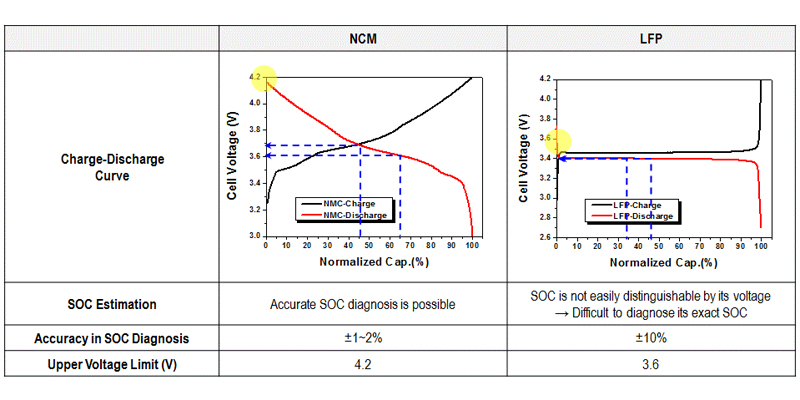
How To Choice The Right One For You?
Commercially, the initial capital expenditure for LiFePO4 cells is generally cheaper than for NMC lithium cells. LiFePO4 batteries are about 20-30% cheaper per kWh, but system integration costs tend to be only about 5-15% cheaper at the beginning of the overall system life cycle.
Operationally, we like the LiFePO4 batteries more relaxed operating conditions – a wider temperature range than NMC, and does not require refrigerated containers for shipping. In addition, LiFePO4battery products generally support up to 1C operation, while NMC lithium ion battery must use power batteries, 2H or 4H different batteries use batteries, support 1C rate (1 hour) applications, and the cost is high.
We believe it is important that customer and investor awareness of NCM lithium ion batteries and companies remains high. But leading lithium iron phosphate batteries and companies have been catching up. Once a product is approved, customers can often easily adopt the same company’s new platform.
Where you can find the best LiFePO4 battery and NCM battery?
ELB manufactures both LiFePO4 and NCM Lithium ion batteries which adopts latest technology. So when trying to decide which battery to purchase consider a few things.
- What application are you using the battery for?
- What is the discharge/discharge current of the batteries?
- The size limitation of the battery space?
- Energy density will be high or low?
Once you have the answers to these questions ELB will help you to determine the best battery for you. Let us know your opinion about the above topic. Any question, welcome to contact with us!


